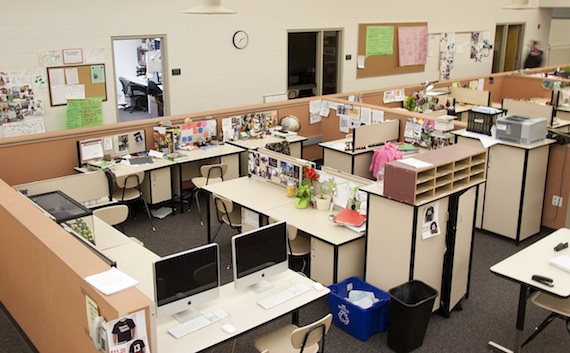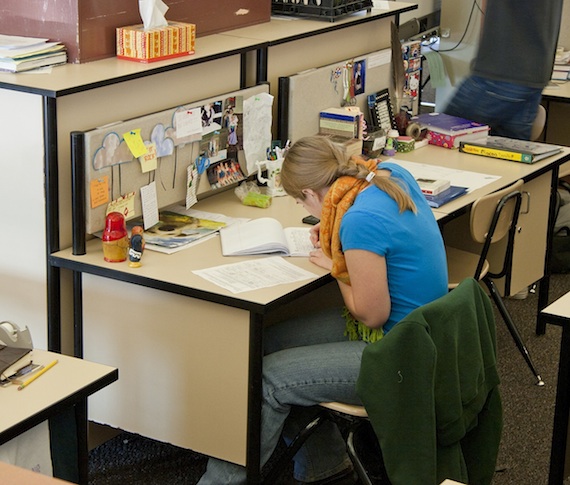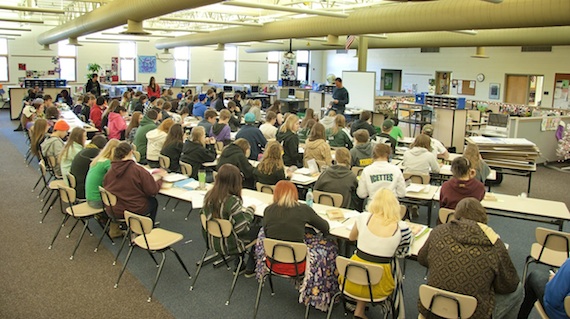Creating an Ultra-Flexible Learning Space
- By Bridget McCrea
- 02/08/12
Designers of the Minnesota School of Environmental Studies (SES) were years ahead of the curve when it came to creating collaborative classrooms that would one day accommodate learning technologies that in 1995 had yet to be conceived--let alone developed and marketed to the educational sector. More affectionately known as "The Zoo School" owing to its location adjacent to the Minnesota Zoo in Apple Valley, MN, the optional high school's design centered on student learning needs, classroom teaching scenarios, and project learning with an environmental theme.
"We challenged the architect [Bruce Jilk of KKE Architects in Minneapolis] to design a facility that would match how we felt learning would occur in the new facility," said Dan Bodette, SES' principal. "As a result our school design is unique and focused on individual students and how they learn."
Workstations, Pods, and Houses
At the core of that design philosophy is an individual workstation for each of SES' 400 students. "The workstation is a lot like a cubicle," said Bodette. "We wanted it to reflect on what the students were going to realize once they gained employment in the work world." When arranged in groups of 10 those workstations form a "pod."
Put 10 of those pods together and the end result is a "house" that accommodates about 100 students. In total there are four different houses that include 10 pods of 10 workstations each. At the center of every house is a large space filled with tables and chairs that can be rearranged to meet student and teacher needs. In each house, three to four teachers team up and teach students for about three hours daily. Within each house is a shared office that's used by teachers who keep their doors open to students and also spend time with them in SES' open, community areas.


Cubicle-style pods are made up of 10 individual workstations each. |
Within the learning space students work independently at their individual workstations, collaborate in small clusters, or converge into larger groups--all with just a few quick furniture moves. Bodette said the arrangement works well in the magnet school environment where instructors combine English, social studies, science, and other subjects in a team-learning setup.
"We're not always sure who the 'specialist' is in any subject area," Bodette explained, "so we need a large, flexible space that's adaptable to that environment." The open space at each house's center allows for various learning episodes, he added, and "varies greatly from the typical 30' x 30' classroom filled with rows of desks and a teacher lectern."

SES houses are made up of 10 pods and accommodate 100 students each. There are four such houses at the School of Environmental Studies. |
The Zoo School, which serves 400 students in 11th and 12th grade, encourages students to customize their workstations--much like employees do in the work environment. Bodette said he sees this feature as the modern-day answer to the student locker, which is non-existent at SES. "When students plaster their favorite pictures and things on the back of their desks," said Bodette, "it's easy to recognize who they are."
Open Concept
Situated on 12 acres of Minnesota Zoo property, SES has its own outdoor classroom where students can get hands-on with their environmental studies. Nature trails, wooded areas, a large pond, and a regional park (situated across the street from the school) are just few of the space's interesting features. "The natural ecosystem on our wooded property serves as an extended classroom for students," said Bodette.
Cumulatively the various features that went into SES' design have withstood both the test of time and the onslaught of technology in the high school classroom. According to Bodette, since its doors opened 17 years ago, the Zoo School's structural and design components haven't changed much at all. A few of the light modifications included replacing wired Internet connections with campus-wide WiFi, installing interactive whiteboards in all rooms, and adding portable laptop stations in the school's public areas.
Sometimes a lack of walls and/or barriers between rooms can create challenges that teachers don't grapple with in traditional classrooms. Controlling noise can be particularly difficult for teachers who use speaker systems, moveable white boards, conference rooms [for one-on-one sessions with students], and their own "outside voices" to overcome the challenge. "There's some spillover of sound," said Bodette, "but once you start putting up walls to control that issue you limit your ability to adjust for different group sizes and lessons."
Bodette doesn't foresee any design changes in store for The Zoo School's campus in the future. More technology will be incorporated into the classrooms, he said, but the open design concept will remain in place. "The physical structure has worked so well that we really don't plan to make any adaptations to it," he said. "Our kids are thriving here."